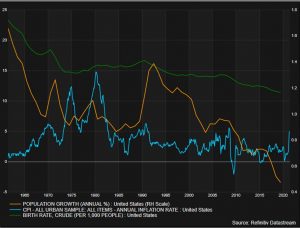Concerns about inflation have taken center stage in the financial and mainstream press over the past six months as various Consumer Price Index (CPI) and Personal Consumption Expenditure (PCE) readings have come in relatively red-hot, at least compared to the past decade. There has been considerable commentary from various pundits about how these readings are indicative of the beginning of an inflection point in the reversal of a multi-decade disinflationary trend that has gripped the world since the 1980s. Their arguments seem to span everything from increasing producer prices related to a renewed commodity cycle (or supercycle), to the reversal of globalization arising from the growing tensions between the China and the West leading to a multipolar supply chain which will cut off the West’s access to cheap labour and goods, to unbridled government spending during the pandemic lockdowns becoming more entrenched, especially with respect to monetary support and legislated wage increases, to the effect of ultra-accommodative central bank policies that might become permanent fixtures in the form of debt-monetization or Modern Monetary Theory. Sometimes the arguments for an inflection in inflation are as simple as the closer we get to 0% with inflation and interest rates, the more likely that they will pivot higher, though we would suggest asking Europe and especially Japan how that’s going.
We, however, are more of the view that this year’s jump in inflation readings is indeed transitory and is the product of a combination of factors such as year-on-year comparables, supply-chain bottlenecks (especially with respect to the shift in consumer patterns to goods from services during the lockdowns), and what we could consider typical economic conditions during an early-cycle recovery as initial capacity constraints are hit as the economy rapidly closes in its output gap from a recession. All of which we would posit in this cycle as being directly linked to effects of the lockdowns on the global economy.
If anything, we view inflation’s downtrend of the past 40 years as secular and unrelenting in the medium to long term. Why? We have heard various iterations of the expression of inflation being driven by the “3 Ds”, but the one we most agree with is Debt, Deflation, and Demographics. Debt, both at the private and public level, can be disinflationary as debt servicing costs crowd out other spending and high debt can represent a saturation level that prevents further borrowing and, in turn, spending. Next, the reference to Deflation often speaks to the idea of technology and automation replacing jobs and sapping wage growth, thus reducing the population’s spending power. However, we would also frame this second D as also the product of the hyper-inflation of broad asset prices from aggressive monetary accommodation and unorthodox policies from central banks over the past two decades, especially with respect to real estate, that has had a powerful deflationary impact in pricing out the younger generation from access to home ownership, which in turn harms household formation, discretionary spending, and plays a major role in exacerbating what we consider to be by far the most important D of the three; Demographics.
The relentless slowing of the birth rate (green) and growth rate in the population (amber) are the driving factors in why we consider demographics to be the most powerful force reducing the rate of inflation (blue) over the past 40 years, as seen from the chart below. Japan and Europe are well ahead of North America on this trend and it is evidenced in their relatively sluggish economies and low to deflationary rates of price changes. If anything, it is our view that not only will the recovery from the pandemic not result in a turning point in the long term downtrend of inflation, but instead since the lockdowns caused such a dramatic drop in birth rates across the developed world (https://www.bbc.com/news/world-56415248)( https://www.nytimes.com/2021/05/05/us/us-birthrate-falls-covid.html), they may in effect simply reinforce the already extant secular disinflationary trends in place prior to pandemic. As a consequence, when it comes to portfolio composition, we believe there is a likelihood that we will revert back to a scarcity of growth investment climate that will likely see growth style continue to be favored over value.







